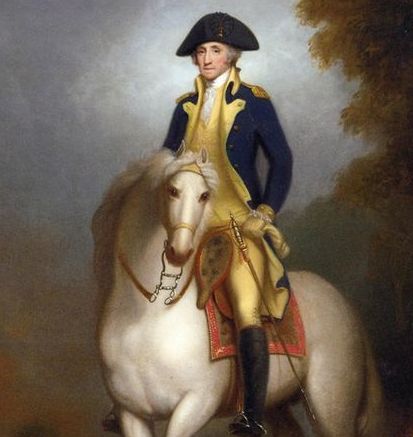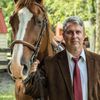
With the current White House embroiled in epic battles with the national media, it is worth remembering that America’s First President was not only a champion of press freedom but also an enthusiastic patron of the arts.
As George launched his military career, he was enjoying a modish life in Williamsburg and in the parlors of elegant plantation homes along the Potomac and James Rivers. By the 1750s, the capital of Virginia, Williamsburg, was fully immersed in the Augustan Age of literature, which witnessed an explosion of drama and fiction, including new plays marked by scathing satire, often with ironic twists aimed at highlighting or pillorying societal norms. George’s personal development ran parallel to this age of wit and wisdom.
Comedies of manners, as they were called, became all the rage in Williamsburg before and after the French & Indian War. Virginia, like mother England, was learning to laugh at society, but, in particular, to make fun of stuffy, wealthy types who typified the ruling classes. Leading characters in such dramas were marked by their acute character flaws, which—more often than not—made them comedic misfits. Other stage stories delved into scandal as well as into the outrageous behavior of the powerful.
Though he sometimes did take Martha along—and sometimes also their two children— George usually attended the theater alone, albeit often meeting up with friends and his fellow Virginia burgesses. On several occasions, he found himself at the theater in Williamsburg in the company of a young Thomas Jefferson, who – in contrast to George, who liked his expensive “box” seats -- often enjoyed watching performances from the rowdy “pit” beneath center stage, where detractors could throw rotten apples and orange peels if they didn’t like what they saw. Virginia Gentlemen like Washington and Jefferson, who spent the day arguing politics, often retreated to the theater to discuss ideas, smoke, drink, and watch others entertain them on a stage that in many ways mirrored life in London.
As they bore witness to an explosion of satire and wit on center stage, these American men (and women) of that Augustan Age, became leaders and critical thinkers in their own right. Indeed, it is hard to see how Washington would have become the same inspired hero of the Revolution and advocate of a vibrant arts scene had he not been exposed to this rollicking age of drama at an early age.
During the American Revolution, George Washington established himself as an unmatched advocate of arts and ideas. Though some leading northern patriots like Samuel Adams condemned theatrical performances, saying they led to “Vice Idleness Dissipation and General Depravity of Principles and Manners,” Washington, long a lover of both the fun and moralizing impact of good theater, thought and acted to the contrary.
At Valley Forge, George made a concerted effort to support the arts, particularly drama, insisting on its inherent and edifying value, despite the reservations of more puritanical-minded members of Congress. The lead production at Valley Forge in 1778 was Addison’s play, Cato, already immensely admired by George from his early days at Mount Vernon in the company of his half-brother, Lawrence, and his early romantic interest, Sally Fairfax. As George matured, the lines of Cato resonated more and more with him, particularly as a reflection of how he wanted to be remembered as a leader. In the play, the character of Cato queries philosophically, “What pity is it that we can die but once to serve our country?”
George’s inherent faith in independence and his ideas of freedom from tyrannical rule buoyed his belief that a battle of ideas was worth engaging in. The arts provided a means for him and his fellow Americans to envision their own ideals—to put meat on the bone, so to speak. It was this faith in his own ideals that guided his evolution as one of America’s earliest and most influential patrons of the arts. This evolving role was never a given, especially if one considers that, unlike many of his own peers, George did not have a formal education.
It was in this same era that a free-wheeling American press made its mark as a dogged and scathing critic of higher authority – namely the British Crown. George knew artists and writers would play a key role in the success or failure of the Revolution. From his desk at Valley Forge, he wrote to the young poet Timothy Dwight to encourage him, stating that nothing would please him more “than to patronize the essays of Genius and a laudable cultivation of the Arts & Sciences, which had begun to flourish in so eminent a degree, before the hand of oppression was stretched over our devoted Country.”
In the wake of the Revolution, his adamant belief in the new nation’s need for literature, drama, and art would evolve further. He would remark that “every effort in genius, and all attempts toward improving useful knowledge ought to meet with encouragement in this country.” Patronizing the arts was not universally approved of, but George understood its critical value to the Revolution. As admirable and eloquent as his love of the arts sounds today, it also was part and parcel of a radical new era. Throughout modern history, rebel leaders have promoted freedom for “the muses,” often with the sole intent of burnishing their own heroic images. With many so-called “modern revolutionaries,” a respect for the independence of art and literature dwindles once they have achieved their ends. Not so with George Washington, who would to his dying day be pleased to see writers, poets, and even his own critics unfettered by moral and legal restrictions.
As the new nation grew, George proved to have grasped the useful and symbiotic relationship between an independent leader and an unfettered artist and writer. In May of 1788, George wrote to the Marquis de Lafayette, stating: “Men of real talents in Arms have commonly approved themselves patrons of the liberal arts and friends to poets, of their own as well as former times,” adding that, “In some instances by acting reciprocally, heroes have made poets, and poets heroes.” He was, of course, a great actor on the stage of history and politics, but he also knew that no great actor could survive without a proper playwright or poet —the taste of whose fruits he had long since begun to savor.
In comparison with today’s spectrum of journalists, in eighteenth century Europe and America, a far greater proportion of them also doubled as poets. Washington knew well that these men held the key to breaking down the old symbols of power and building up the new ones. He would write to Irish journalist and poet Mathew Carey in 1788 that his publication was “more happily calculated than any other, to preserve liberty, stimulate industry and meliorate morals of the enlightened and free People.” At the time of the Revolution, however, he probably never imagined how or why some of the most polished scribes in America would eventually turn on him and write scathing indictments of his government’s alleged corruption and his own “royal aspirations.”
Artistic expression as it developed out of the Revolution helped the new nation establish a truly American identity infused with the ideals of the Revolution and unique to the New World. Some of George’s dogged openness to artistic and press freedom is likely also attributable to his old friend George Mason, who in 1776 had written in the Virginia Declaration of Rights “that the freedom of the press [and speech] is one of the great bulwarks of liberty, and can never be restrained but by despotick governments.” This idea of preserving a free press was growing in currency even in Europe. The last thing George Washington ever wanted to be accused of was setting up a new form of despotism – or, for that matter, promoting monarchical habits.
Once the embodiment of all goodness and devotion born in America, as President George would – as First President -- come under sharp attack from America’s biting press, which he had allowed to flourish without censorship. His unjust and ironic reward for fighting to oust a monarch from American shores, was that he was now accused openly of coveting a crown. There was still nothing to the rumor, but his long-time colleague Thomas Jefferson, who once famously said he would rather have a free press than a government, spent considerable time and ink in the 1790s fanning the flames over the imagined threat of a new “King George.”

Convinced of America’s sound republican virtues, the commander in chief looked fairly unflappable. Well, almost: At a cabinet meeting, Gen. Henry Knox, who served as secretary of war, seized upon a newly published satire in the press titled “The Funeral Dirge of George Washington and James Wilson, King and Judge,” a playful little drama in which Washington was dragged before the guillotine for alleged “aristocratic crimes.” It was light satire, but it went too far for the President. George’s temper, which he struggled to control all his life, blew a fuse, and Thomas Jefferson described the rage of the president in these words: Washington went into a tirade, he said, and shouted that he would “rather be on his farm than be made emperor of the world, and yet that they were charging him with wanting to be king.” It wasn’t the first time he had been ridiculed, and it would not be the last, but even magnanimous George had his limits.
He was at the end of his rope (and almost his presidency), and he soon wrote to a refined female friend—as he often did when he was down on his luck—that he certainly had no “ardent desire to be butt of party malevolence,” adding, “Having tasted that cup I found it bitter nauseous and unwholesome.” George had done his best to set an example of tolerance and support for a free and animated press, but now it was time to make a tactical retreat with his equally-weary Martha to the relative calm and civility of Mount Vernon.
Philip Smucker is the author of the forthcoming (June-July) Riding with George: Sportsmanship & Chivalry in the Making of America’s First President. Explore and Learn on the web.
